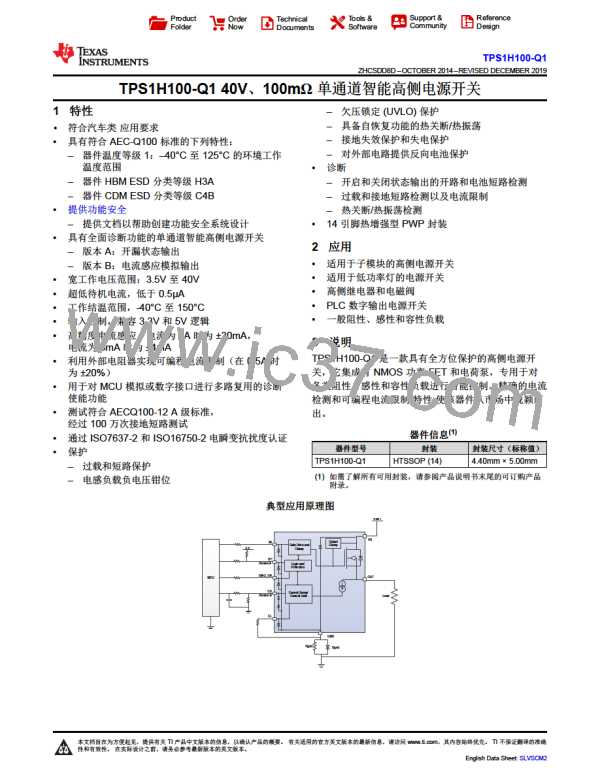TPS1H100-Q1
www.ti.com.cn
ZHCSDD8D –OCTOBER 2014–REVISED DECEMBER 2019
Method 2 (GND network protection): Only the high-side device is protected under this connection. The load
reverse loop is limited by the load itself. Note when reverse polarity happens, the continuous reverse current
through the power FET should be less than Irev. Of the three types of ground pin networks, TI strongly
recommends type 3 (the resistor and diode in parallel). No matter what types of connection are between the
device GND and the board GND, if a GND voltage shift happens, ensure the following proper connections for the
normal operation:
•
•
Leave the NC pin floating or connect to the device GND. TI recommends to leave floating.
Connect the current limit programmable resistor to the device GND.
DRAIN
IN
Output
Clamp
Gate drive
and Clamp
STATUS
Version A
Logic and
Protection
DIAG_EN
SOURCE
CS
Version B
Current Sense/
Current Limit
Load
NC
(Floating)
CURRENT LIMIT
GND
VBAT
Rgnd
Dgnd
GND
Network
Figure 42. Reverse Protection With GND Network
•
Type 1 (resistor): The higher resistor value contributes to a better current limit effect when the reverse
battery or negative ISO pulses. However, it leads to higher GND shift during normal operation mode. Also,
consider the resistor’s power dissipation.
VGNDshift
RGND
Ç
Inom
œV
(9)
(
)
CC
RGND
í
œI
GND
where
•
VGNDshift is the maximum value for the GND shift, determined by the HSD and microcontroller. TI suggests a
value ≤ 0.6 V.
•
•
•
Inom is the nominal operating current.
–VCC is the maximum reverse voltage seen on the battery line.
–IGND is the maximum reverse current the ground pin can withstand, which is available in the Absolute
Maximum Ratings.
(10)
If multiple high-side power switches are used, the resistor can be shared among devices.
Type 2 (diode): A diode is needed to block the reverse voltage, which also brings a ground shift (≈ 600 mV).
•
Copyright © 2014–2019, Texas Instruments Incorporated
29

 TI [ TEXAS INSTRUMENTS ]
TI [ TEXAS INSTRUMENTS ]